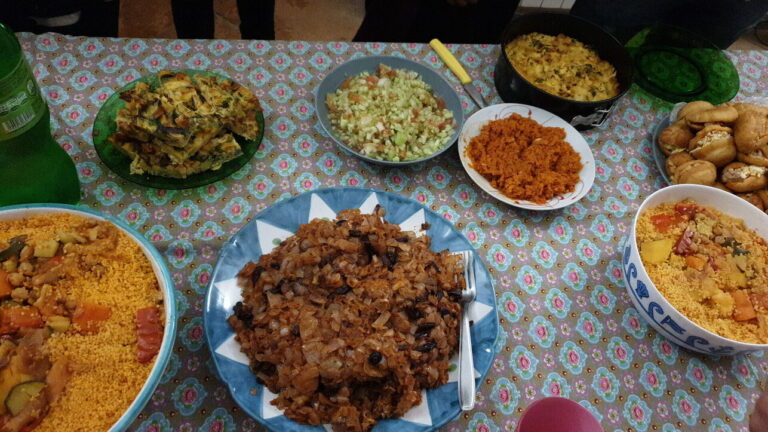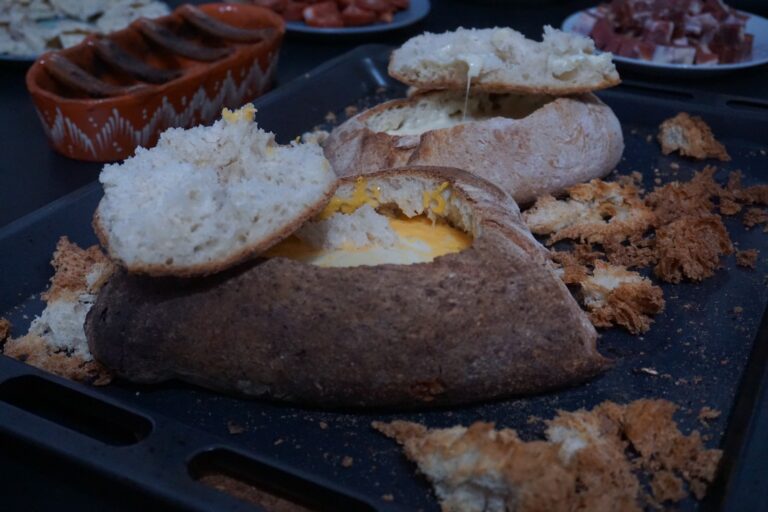Updated on January 6, 2023
An Invitation to the Cultural Nights
An important aspect of the project is the cultural exchange. It is a central dimension that we live every day, being diving into Italian culture but also surrounded by the cultures of each of us. However, there is a particular moment in which this exchange becomes even more conscious, even stronger: it is during the cultural nights, in which one country is in the spotlight, with emblematic dishes, music, games, dances, stories and explanations shared together, in a magical moment which involved a bit our families too. Indeed, with their advice, the food specialties they provided or even their presence during the event for some, they added a special touch.
In these moments, we can understand a bit better the essence of where we come from, with our personal and national history, that get mixed well to add a bit of diversity to the melting pot of cultures we have lived and shared every day. These nights are also the opportunity to see what unite us, beyond borders, what we have in common whether we are from the Mediterranean coast, from the mountains or from the Northern latitudes. To make you understand a bit more what it is all about, here is an invitation to the cultural nights with this little article!
- Italian night (29 April 2022)
This night was the first one of our project, and one of the most enriching. It was the occasion to discover Italian culture in a very interactive way, between language game, cooking activity and cultural discussions. We learned to prepare two recipes of local delicacies, with all their story surrounding them, particularly thanks to Alba and Domenico Palumbo.
First, it was the turn of pasta alla Nerano, valued specialty of the peninsula which finds its origins in the “Maria Grazia” restaurant in Marina del Cantone, in the 1800’s. This recipe has been a beautiful introduction to the local gastronomy, with the use of three cheese types (caciotta, parmigiano, caccio cavallo) which mix into this creamy dish of which every local family has a different version. Some prefer to make the pasta creamy, others to add a bit of grated lemon skin… For Alba however, the final touch is the fresh basil leaf, which gives a certain elegance obviously!


Then, we started the preparation of limoncello together, another great symbol of the peninsula! With twenty something small peeled lemons, we created a basis for the conception of a short maturation liqueur. The following month it was ready – with other determinant steps of which we have now the secret…–. Joke aside, if you want to know more about these recipes, here there are (in Italian), drawn by me!




- Spanish night (15 June 2022)
The Spanish cultural night has been a great occasion to meet Claudia’s parents: with an Aragonese dad (Mariano), a Galician mom (Cristina), who live in Barcelona, the family makes a good synthesis of Spain, with its cultural nuances and its various identities.
The night more than a delicious Spanish food – tortillas de patatas, escalivada (catalana), queso manchego, jamón ibérico and arroz con leche for the dessert! – gave the opportunity to listen to Claudia’s dad, -translated by Olivier- talking about the diversity of Spanish culture, explaining the variety of every comunidad autónoma traditions. After that, there was a beautiful game about the Spanish sayings. It has been beautiful to remember how another language gives this particular look at the world, different from the other languages but also with points of similarity!

Here are two selected sayings:
“Mas sabe el diablo por viejo que por diablo” – The Devil knows more from oldness than from the fact that it is a devil.
This means that the experience gives more knowledge and wisdom than tricks and the inherent intelligence one’s have.
“A enemigo que huye puente de plata” – To the enemy running away, [you give him a] silver bridge.
This saying also quoted by Cervantes in Don Quijote, recommends to free oneself from their enemies or every person who can /want to cause oneself damage. Therefore, every mean to keep the enemies away are valid, including a silver bridge.

- Greek night (28 June 2022)
Another great night of gastronomy, in which Xenia’s parents participated, involving the volunteers, Xenia and her mother (Jenny) to elaborate the typical dishes, including moussaka, tsatziki con “fried zucchini” (kolokithakia tiganita), gemista e choriatiki (salad). These Mediterranean flavours made Mahdi say “it’s like another type of Tunisian food that I don’t know of yet!”, underlining the shared influences from a Mediterranean coast to another.


Once a more, evocated through traditional dances of the Pontos region (Pontus), the particular story of Xenia’s family has been the occasion to discover another facet of Greek culture. Indeed, with these dances, sirtaki e kotsari – learned from Xenia’s dad side (Thodoros) –, it allowed us to catch a glimpse of a Greek population who lived on the Black Sea coast and who transferred to Northern contemporary Greece in the moment of the population exchanges between Turkey and Greece in the 1920’s. Theodoros also made us discover tsípouro, a typical Greek liqueur that accompanied this convivial moment.
The dance all together, also with our American interns friends, will remain a great moment of conviviality, living the Greek culture, through its more lively form.
- French night (17 August 2022)
For the French night, happening a little after Ferragosto (15th of August), it has been the occasion to cook together, also with my parents and my brother. The occasion to celebrate outdoor, in a period that made sense, because coinciding with the period of celebration in my village.
We started with an aperitivo with various typical products of the département I come from, Cantal: cheeses (cantal, saint-nectaire), various types of dried meat and a blond lentils salad.


After, we ate truffade, this typical dish of the village celebrations, made of potatoes and fresh tomme, prepared with the direction of my dad, more particularly to make the long strings of melt cheese while serving. My mom prepared plum clafoutis for dessert.



All helped to prepare and the summer atmosphere on the terrace added a touch creating a nice convivial moment. After some explanations about the dishes and enjoying the dinner, we started the also typical activity of my village celebrations: the “boules carrées” (‘squared boules’) tournament. This game of boules with wooden (pine) cubes was invented to be able to play on sloping ground in the mountainous countryside. Rita, Alessandra, Boris and I, with the help of a carpenter from Monticchio (Salvatore), handcrafted the boules. This night has been the perfect opportunity to play in Conola garden, with the adequate slope to make the cubes roll – but not too much.





It was also the first cultural night with all the volunteers together, after months with always one missing or more (with the turtle monitoring in Cilento). A familial, friendly moment, to remember, like all the cultural nights.
- Tunisian night (5 November 2022)
This celebration was also a great culinary experience. The dishes were numerous, prepared with all of us, with the direction of Ons and the support of Anas and Mahdi, but also the precious help of last year volunteers, the great Mehdi and Mayssa!

There were of the table so many colourful and tasty dishes: امك حورية (omek houria), طاجين (tajine), سلاطة مشوية (mechwia salad), سلاطة خضراء (“green salad”), كسكسي (couscous), شرمولة (charmoula) – a typical dish from Monastir, Ons and Anas’ city–,بريك (brik), but also فريكاسي (fricassé). The chance to taste also this emblematic ingredient of Tunisian cuisine, a type of puree made with a basis of red chili peppers, garlic and olive oil: harissa (هريسة). This dressing is also the symbol of the diversity of Tunisian culture because its recipe varies between every family – and also inside the same family – or Tunisian region. Then, as desserts, to delight our taste buds, there were بوزة (bouza) andيويو (yoyo), who get very well together.


After dinner, we made a game to identify our names in Arabic and then write them with the Arabic alphabet. We also played a game about the resemblances between Tunisian language and Italian, looking for the words with Italian sounds in Tunisian, sign of close contacts between the two countries.
Following this, we shared a bit of dancing and a bit of music to conclude a very warm cultural night, perfect in the grey and rainy period of autumn.

- Portuguese night (10 December 2022)
Everything started with the World Cup match opposing Portugal against Morocco, perfect moment to share an aperitivo all together, with Portuguese products sent by Pedro’s family (dried hams, herb-flavoured cheeses, lupin beans, pão recheado,…). Luís, friend of Pedro who came for the cultural night, also made us discover chouriços, alheiras, morcela and linguiças, types of sausages – some of them were vegetarian –, flambé in a specific oval dish, called “assador de chouriços”.



Then, we participated to a general knowledge (cultura geral) game, with crossed words in Portuguese about geography, music, or even football in Portugal. The occasion to know more about this beautiful country with an Iberian culture, looking towards the Atlantic.
After that, the cultural night kept going with the continuation of the buffet, but with warm dishes, and still during the whole event, the assador was on. We tasted as the first dish, a canja, followed by migas and alho francês à Brás, to finish with a serradura, a creamy dessert. All of this with a soundtrack composed of fado, Antonio Variações and other Portuguese songs to dive into the culture of the country of carnations.

To know more about these dishes, here are the favourite recipes of Pedro, with their short presentations:
- Migas
“For centuries “migas” have been a traditional dish eaten in the Alentejo region, especially in winter. It is a highly caloric dish that was born as a way to make the most of the bread, already very hard, and that fed the men who worked in the fields.”
Ingredients:
– 0.5 pack of corn bread (broa)
– 0.5 package of cabbage or something similar (couve para caldo verde)
– A specific type of beans (feijão frade)
– Salt
– Black pepper
– Chopped garlic to taste
– Olive oil
Preparation:
Place a pot of water seasoned with salt on the stove and when it is boiling add the chopped cabbage, and let it cook. Meanwhile, break up the corn bread into small pieces.
After the cabbage is cooked, drain it and set it aside. In a large pan, add the chopped garlic and olive oil, let the oil heat up, then add the crumbled corn bread and stir. Then add the cabbage and the beans and mix everything together, add more olive oil if necessary.
You can use olive oil flavoured with garlic, which is tastier.
- Alho Francês à Brás
“Alho Francês is an option to replace the codfish (traditional dish). Can be done with chicken and other proteins. It is widely consumed in Portugal and also in Macau. The excellent flavour depends on the relationship of the components of the recipe, especially the amount of onion in relation to the cod and the olive oil used to make this dish. The recipe was created by a tavern keeper from Bairro Alto, in Lisbon, by the name of Brás.”
Ingredients:
– 20 ml olive oil
– 1 onion cut into half-moon slices
– 100g of the white part of the leek, sliced
– 1 bay leaf
– 100g fried potato sticks
– 2 eggs
– Salt
– Black pepper
– 1 sprig of chopped parsley
– Black olives
Preparation:
- Break eggs into a bowl. Season with salt and pepper. Beat well with a wire rod.
- In a pan heat the olive oil, the bay leaf and the onion. Stir and let it braise a little. Add the leek.
Mix together and cook for about 5 minutes over medium heat.
- Add the potato. Mix well and allow to heat through. Add the eggs, stir and cook over medium heat
for about 30 seconds. Be careful not to overcook the eggs.
- Finally, add the chopped parsley and remove from the heat. Accompany this dish with olives.
- What’s next
This is a list that is going to be augmented, with the future Croatian and Belgian cultural nights! More than a list, with this article I wanted to show the beautiful moments of exchange and sharing that punctuated our volunteering. The cultural nights have always been powerful moments out of time, precious moments, but also – to be honest – a bit stressful for the ones who have to organise it, because it is not a simple thing to highlight the essence or at least a personal angle of your own culture. At the end of the day, after a bit of adrenaline, the fact to see all the volunteers, mentors, friends of the project, and also families and friends of the volunteers enjoying these special moments, it is without a doubt one of the most beautiful things of the carrying out of these. I recommend you, if you have one day the opportunity to create events as much convivial with family or friends, do not hesitate! A cultural night is always worth it, in the sense that it also makes yourself discover what means your own culture, and it makes (re)discover subtleties and evidences of this one, always beautiful to share with others.
To conclude, I would like to thank all those who organised, helped, prepared and to sum up allowed these unforgettable nights to happen. Our mentors, coordinators, Gianna, Nacho, Mimì, Alba ; but also all the volunteers, the friends of the project like Alessandra, and many more who added their touch in the cultural exchange in general, but even more during these high points of the project. Grazie di cuore.
— Paul Descoeur






